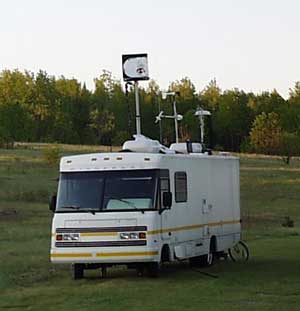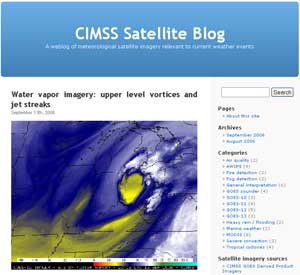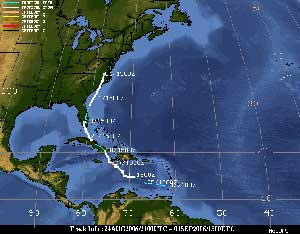Monthly News Summary – September 2006
NSF to fund instruments
|
NSF will provide approximately $1.2 million to add two new instruments to SSEC’s mobile weather lab. The lab is a modified 1994 Winnebago called the AERIbago.
|
SSEC recently received confirmation that theNational Science Foundation will provide the Center with approximately $1.2 million to add two more instruments to its mobile weather lab—a modified 1994 Winnebago called theAERIbago.
The AERIbago is in part named for one of the instruments on board – theAtmospheric Emitted Radiance Interferometer, or the AERI, a ground-based instrument developed at SSEC to observe the atmosphere. The two new instruments will enhance the measurements taken by the AERI and the other instruments aboard the ‘bago.
One of the new instruments will measure the properties of cloud particles and aerosols by emitting laser pulses that change direction, or scatter, when they collide with objects such as cloud particles and pollutants called aerosols. Portions of the laser beam bounce back to the instrument, which then analyzes how the beam has changed and determines how long the beam took to return. The changes to the beam give an idea of the particles’ properties and the time measurement indicates how high in the atmosphere clouds and aerosols are located. SSEC has had a significant role in developing this instrument called a lidar for Light Detection And Ranging.
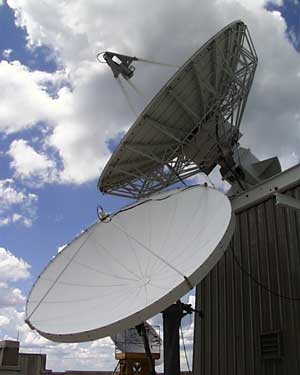 |
|
SSEC will be able to put the two new instruments on the roof of the Atmospheric, Oceanic and Space Sciences Building where a suite of instruments already resides.
|
The other instrument that will go in the ‘bago with NSF funding is an instrument that gathers information about the atmosphere in the microwave region of the electromagnetic spectrum. Microwave radiometers (MWR) are particularly useful for sensing water concentrations in the atmosphere. The MWR in the AERIbago will gather data in three bands, rather than the standard two, making it more sensitive to the amount of liquid water in the atmosphere.
The two new instruments will be easy to remove from the ‘bago. This capability will allow SSEC to put the instruments on the roof of its home in the 16-story Atmospheric, Oceanic and Space Sciences Building on the UW-Madison campus. The roof already houses a suite of instruments that routinely observe the atmosphere.
The addition of the technologically advanced lidar and MWR will facilitate improved cloud studies. The instruments will contribute to analyses of mixed-phase cloud and will increase knowledge of the atmosphere under cloudy conditions. Beyond the unique scientific opportunities, undergraduate and graduate students will have the chance to participate in the development and installation of the instruments as well as the design and execution of related experiments.
written with assistance from Steve Ackerman
Local weather page receives a makeover—SSEC’s local weather page recently received a makeover. The redesigned page highlights current conditions in Madison and daily forecasts. The page also includes an animation of visible imagery of Wisconsin from one of the U.S.’s geostationary weather satellites, the Wisconsin weather plot generated by the National Weather Service, and Midwest radar data. A “More Weather” link provides links to a precipitation forecast created with CIMSS’s experimental weather model, national radar and satellite composite imagery, and links to several different sources for text weather information. SSEC’s Webmaster,Bill Bellon, redesigned the page to make it more useful to a casual weather data user. Those interested in more detailed weather information can refer to the CIMSS Weather Page.Showcasing satellite research—On August 18, a research meteorologist with CIMSS launched theCIMSS Satellite Blog. With this blog, Scott Bachmeier hopes to highlight work done by researchers at CIMSS using satellite data and products. Posts present and provide discussions of images relevant to current weather events. So far, topics have ranged from tropical cyclones to fire detection to air quality. Although Bachmeier is currently the only blogger, he welcomes input from his colleagues. Updated regularly, the CIMSS Satellite Blog provides an excellent source of information about fascinating satellite-related research and technology, and, of course, stunning imagery.
SSEC data used at local NWS office—This summer the National Weather Service (NWS) office near Milwaukee (MKX) began receiving two types of data from SSEC. During July, MKX started to work with imagery from the Moderate Imaging Spectrometer (MODIS). At the end of August, MKX started using forecasts generated with the CIMSS Regional Assimilation System (CRAS). Both the CRAS and the MODIS data were integrated into the Advanced Weather Interactive Processing System (AWIPS), which NWS uses to process and analyze weather data. According to Jordan Gerth, an undergraduate research assistant with CIMSS, the meteorologists at MKX are “truly appreciative.” Gerth also mentioned that Rusty Kapela, a meteorologist, “was amazed at how closely the CRAS resembled actual imagery.”
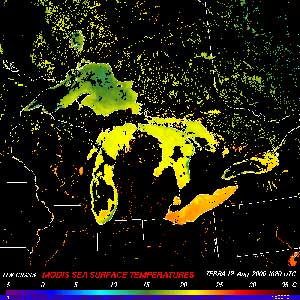 |
|
A forecast discussion at the National Weather Service office near Milwaukee mentioned this image in a forecast discussion on August 12.
|
Since they began receiving CRAS and MODIS data, forecasters at MKX have referenced both in several forecast discussions. On August 12, an MKX forecast discussion mentioned the MODIS sea surface temperature product: “The 1 km MODIS imagery has been very interesting showing the narrow cool upwelling areas on the east shore. This imagery will be useful in detailing the transition into and out of upwelling cooling and when east winds push warmer surface waters across [the] western shore.” On August 30, an MKXforecast discussion praised CRAS forecasts: “In the near term first look at CRAS model satellite imagery is very impressive. So much model information is being presented in one image that can be easily digested.”
Archiving GOES—Earlier this year, the staff of SSEC’s Data Center began to transfer the Geostationary Operational Environmental Satellite (GOES) data archive from tape to online storage. As of the end of August, they had transferred data from the present back to 2002. A preview of the data is now available, though the archive is still under construction. Over the next couple of years, the Data Center employees hope to move the entire GOES archive. As a longer term goal, they eventually hope to put all of the data archived at the Data Center into online storage.
Published— The IEEE Transaction on Geoscience and Remote Sensingincluded a paper co-authored by Peng Zhang, Jun Li, Erik Olson, Tim Schmit (NOAA at SSEC), Jinlong Li and Paul Menzel (NOAA at SSEC). The paper is called “Impact of Point Spread Function on Infrared Radiances from Geostationary Satellites.” The conclusions presented in this paper will contribute to the process of designing a cost-effective yet scientifically and technologically advanced sounder for a geostationary satellite.
DISC on the move—The August edition of VECO Polar Resources’s newsletter mentioned the Deep Ice Sheet Coring (DISC) drill, which SSEC’s Ice Coring and Drilling Services (ICDS) designed and constructed. The DISC drill was in Greenland for a field test before heading to Antarctica for the West Antarctic Ice Sheet (WAIS) divide ice core project. The article referred to the more than 122,000 lbs of DISC cargo that was recently flown out of Greenland. An image of one of the crates full of DISC equipment accompanied the article. The transport of the ice cores taken by the DISC drill during testing also made it into the article. The cores had to fly in a “cold deck” plane, which means that the heaters were not on during the flight.
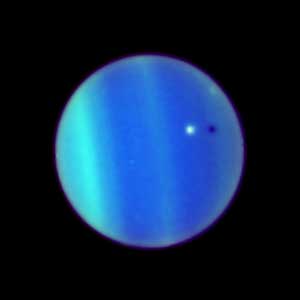 |
|
Using the Hubble Space Telescope, a team led by Larry Sromovsky observed Ariel, one of Uranus’ moons, as it traveled across the planet’s face.
|
Moon eclipses Uranus—Using the Hubble Space Telescope, a team led by Larry Sromovskyobserved one of Uranus’ moons as it made its way around the planet. Due to Uranus’ 84-year orbit around the sun and the planet’s sideways polar axis, this is a rare occurrence never before observed by human beings. “Uranus has the most extreme seasonal variation of sunlight you could imagine,” says Sromovsky in an August 31 UW news release. “If you lived at the pole of Uranus, you wouldn’t see the sun for 42 years, and then you wouldn’t see darkness for another 42 years.” The Space Telescope Science Institute simultaneously released the images on its Hubble Images web site. Alan Boyle, MSNBC.com’s science editor, wrote about the images in his blog called “Cosmic Log” on August 31. Science News printed an article titled “Rare Uranian Eclipse” in its September 9 issue. Among other news outlets that referred to the eclipse are Space.com, Space Daily, and theWisconsin State Journal.
Investigating Venus—Recently, some old work done by SSEC’s founder, Verner Suomi, and Sanjay Limaye appeared on the European Space Agency’s Venus Express Web site. A June 27 Venus Express news releaseannounces that Venus Express data “undoubtedly confirm … the presence of a huge ‘double-eye’ atmospheric vortex at the planet’s south pole.” Limaye and Suomi observed Venus’ stormy atmosphere in the early 1970s using Mariner 10 and an instrument on the Pioneer Venus Orbiter. Images from both accompany the recent news release. SSEC’s Office of Space Science Education (OSSE) also leads the education and public outreach element of the Venus Express mission.
Dusty air may hinder hurricanes—A mass of dry air laden with dust originating in the Sahara might have something to do with this year’s relatively calm hurricane season. In an August 20 article from The Tampa Tribune, reporter Neil Johnson explains Chris Velden’s studies of the Saharan Air Layer’s effects on tropical cyclones in the Atlantic Basin. Velden and fellow researcher Jason Dunion (NOAA) developed a technique to detect and track the SAL using multispectral information from GOES. According to the August 20 article, the SAL moves at an altitude where circulating winds tend to grab the moisture necessary to fuel a storm. This year, Velden says, the SAL is thicker and covers more of the ocean than usual. The article also notes that, though this year’s hurricane season seems tame, the season is consistent with long-term averages. Velden also provided information about the SAL and its effects on hurricanes to Maya Bell for an August 19 article in the Orlando Sentinel.
Anniversary of Hurricane Katrina—August 29 marked the first anniversary of Hurricane Katrina. A news release from UW-Madison listedChris Velden as a contact for a meteorological perspective on Katrina as well as this year’s hurricane season. In the release, Velden “cautions that the [2006] season is just entering its most active phase.” In addition to offering Velden as a contact, the release touted the efforts of the CIMSS Tropical Cyclones team: “The group forges techniques of use to forecasters, and for any major tropical storm its Web site transfers large amounts of data to researchers, forecasters and the general public.”
Admiration for CIMSS tropical cyclones research—On August 31, blogger Charles Riggs devoted an entire post, titled “CIMSS=Awe2,” to the activities of CIMSS’s Tropical Cyclones research team. “The work they do is daily, ongoing and dedicated to making all the complicated gear tell us something,” Riggs writes. “As scientists, they also get the opportunity to do groundbreaking stuff—satisfying to them and valuable to us. In sum, they do cool stuff that makes property more secure and helps saves lives, darn it.” Riggs also draws attention to the team’s “rippin’ movies.” Specifically, he links to Ernesto, John and Kristy. Riggs writes for the blog “Guided by History,” which Wells Fargo sponsors.
CIMSS aids hurricane forecast—The National Weather Service’sCentral Pacific Hurricane Center mentions three products generated by the Tropical Cyclones team in forecast discussions of Hurricane Ioke on August 25. The discussion refers to the CIMSS ADT estimate, which is generated using a technique to assess hurricane intensity. The team’s wind shear analyses also contributed. The Hurricane Ioke discussion also referred to a CIMSS loop of blended imagery from multiple satellites. The animation, created with a product called MIMIC, showed one indicator of a possible re-intensification, the eyewall replacement cycle, which forecasters at the hurricane center used to predict that the hurricane would return to Category 5 status quickly.
Tropical cyclones site linked—The online version of an article about hurricanes in Physics Today contains links to the hurricane montage archiveand the 2005 Atlantic Basin archive from the CIMSS Tropical Cyclones group. Written by Kerry Emanuel, the article was in the August 2006 edition of Physics Today and discusses the affect of greenhouse gases on hurricane intensity.
Use of Katrina image—NOAA’s National Climatic Data Center used an image from the Tropical Cyclones team’s web site in a recently updatedreport on Hurricane Katrina. The report includes the team’s image of Katrina with the path of the storm included.
Upcoming planetary outreach—On September 20, Rosalyn Pertzborn, a co-investigator for Venus Express Education and Public Outreach, will lead a workshop with Anne Brumfitt (European Space Agency Education Office) for teachers at the EuroPlaNets Meeting in Berlin, Germany. Sanjay Limaye, a U.S. Venus Express Science Team Member, Hakan Svedham (ESA) and Wojtec Markiewiecz (ESA) will also present a science overview of Venus Express for teachers.
Later in September, Pertzborn and Limaye will also conduct the Venus Express workshop for teachers at the International School of Brussels. The following day they will be featured guests of the ISB Middle School and give a full day of presentations on Venus Express, Earth and Climate Change and Juno, NASA’s next mission to Jupiter.
Belated congratulations—Every year the National Oceanic and Atmospheric Administration awards employees who made a significant contribution to the organization during the previous year. Two NOAA employees stationed at CIMSS received silver medals for 2005. Andy Heidinger (NOAA at CIMSS) received a medal as a part of a research group recognized for developing and implementing an innovative technique to intercalibrate satellite instruments while in orbit. As a result of this group’s work, measurements from different satellite instruments are more consistent with each other. This consistency contributes to more reliable measurements of climate change and provides higher quality data for numerical weather prediction models. Jeff Key (NOAA at CIMSS) also received a medal. NOAA awarded Key for his participation in a research group that significantly advanced the use of satellite data in weather forecasting. Key received specific recognition for his work developing a polar winds product and fostering its use in numerical models. Congratulations to Andy and Jeff for this honor!
UW has top R&D status—A news release announced that UW-Madison retains its status as one of the nation’s largest research universities based on the amount of money it devoted to research and development in 2004. The National Science Foundation released these statistics. In the news release, Graduate School Dean Martin Cadwallader says this ranking “is a direct reflection of the efforts of university faculty and staff and their ability to compete successfully in an increasingly difficult funding climate.” SSEC is a dynamic, multidisciplinary research and development center in the UW-Madison’s Graduate School
Thanks from a MODIS product user—A firefighter assigned to a large fire in Minnesota during July admired the MODIS images of Lake Superior processed at SSEC. MODIS images from certain days during showed the smoke plume traveling across the lake. The firefighter requested digital copies of these image and said that they “looked really neat!”
Praise for the Tropical Cyclones team—A recent visitor to the CIMSS Tropical Cyclones page took the time to send the research team a note of appreciation. “I am a fan,” he wrote. “I really appreciate the great work you do.”
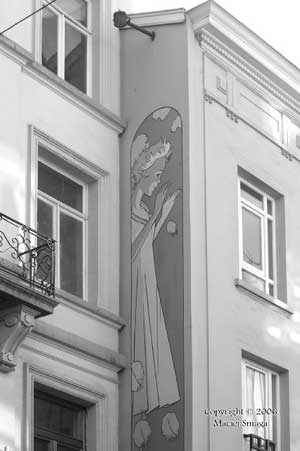 |
|
This is one of the photos in Maciek Smuga-Otto’s exhibit, “Human Places.”
|
Photography gallery—Starting on August 11, Madison’s Escape Coffee began displaying photographs by SSEC’s Maciek Smuga-Otto. Titled “Human Places,” Maciek’s exhibit occupied the shop’s front gallery until August 17. Escape Coffee continues to have some of his photos in the side galleries. The rest of the exhibit is now at the Lutheran Campus Center on University Avenue.
A spike for the capsule—SSEC’sJean Stovercontributed a railroad spike to Madison’s time capsule, which aims to “capture the spirit of Madison in 2006.” The spike, says Stover, came from the Chicago Northwestern Railroad for which her father was an engineer. In a short clip aired on WISCTV, Jean explained that she had “a lot of good memories with railroads.” After the piece aired, however, some discussion of the spike appeared in a forum on the station’s Web site. Several viewers questioned whether the railroad spike was, in fact, a railroad spike. Jean said that she inherited the item among other things from her father and only knew that it had something to do with railroad activities.

